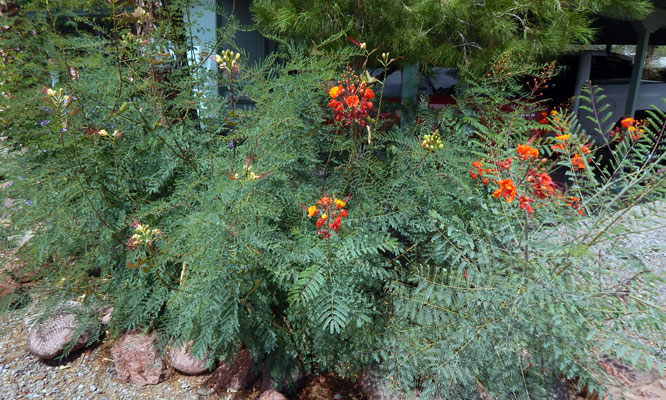Column By Mike Bibb
I have several well-established Bird of Paradise (BOP) bushes growing in my yard — both the red and yellow flowering varieties. They’re probably 15 or 20 years old. Maybe more.
The plants are pretty common. You see them everywhere — residential yards, adorning commercial establishments, and in lane dividers in metro areas, probably, because they’re very decorative, drought and heat-tolerant, and don’t require large amounts of water. Very appropriate for this area of the country.
Ordinarily, my bushes/shrubs load up with seed pods during the early summer months and later begin spreading the seeds in late summer to early fall, accompanied by their familiar “popping” noise, as the pod shells explode and twist into contorted shapes, flinging seeds in all directions.
Honey bees and humming birds delight in their flowery nectar. Actually, it’s not unusual to see both working the plant’s blooms simultaneously and doing what nature intended them to do.
That’s the way things seem to have been designed.
However, not this year. At least, not around my home. A few seed pods are developing, but not nearly as many as in previous years.
Wondering if my bushes were alone in failing to produce seeds, I drove around and observed that other plants appeared healthy and were covered with flowers.
Most of the ones I saw — with a few exceptions — also appeared to be deficient in seeds. And even the heavily laden shrubs didn’t look as productive as usual.
My natural inclination, “What’s going on here?” is probably a fundamental reaction to the situation. For years, there have been plenty of seeds hanging from the plant’s stems, and when it’s time, they burst open to toss the beans in all directions.
“It’s climate change, Mike. Everyone knows that. Wake up!” I fully expect to hear.
In a way, the climate alarmists are somewhat correct; the climate is changing. Over the past several hundred thousand years, it has undergone multiple changes. However, it usually changes so slowly that we hardly notice.
In reality, I suspect that the results of our lingering drought have, for some reason, affected Bird of Paradise seed development this year.
That’s nature — not the end of the world. It seems to work that way. Things are cyclic. They come and go and repeat. Sometimes it’s sunny, sometimes it rains. Sometimes it’s 113 degrees, sometimes it’s 23.
It’s the Southeastern Arizona desert — that’s where I was raised and live. So, I’m kinda used to it.
However, I’ve found out folks in Qurayyat, Saudi Arabia (7,517 miles away), and Firuzabad, Iran (8,029 miles away) experience weather similar to Safford’s. Or at least an outfit called Weather Spark says so. Never been there, so I’ll have to take Weather Spark’s word for it.
Next spring, BOP season starts all over and, most assuredly, things will be almost the same — but a little different.
As an aid to anyone wishing to learn more about growing baby plants from Bird of Paradise seeds, here are a few hints I gathered from the Internet, courtesy of Smart Garden & Home.
Follow these steps to propagate and grow the Mexican Bird of Paradise by seed:
- Collect Seeds in the Fall – Gather seeds in the fall, once the pods turn brown, but before the seeds explode out of the pods.
- Dry Seeds and Store in Fridge – Place the seeds on a towel or cloth in the sun and allow them to dry. Once they have dried out, place them in a sealed glass container and store them in your refrigerator until you’re ready to plant.
- Soak Seeds in Warm Water – Six weeks before your area’s final frost is expected, remove the seeds from the refrigerator and make a small cut in the seed shells. Then soak them in warm water for 24 hours. Remove and dispose of seeds that are still floating and have not sunken to the bottom of the bowl.
- Prepare Container – Prepare a container with one part of potting soil and one part of perlite. The container should feature an adequate number of drainage holes.
- Plant Seeds an Inch-and-a-Half Deep – Place the seeds one-half-inch deep in the container, taking care to leave two inches of space between individual seeds. Water lightly.
- Cover Container and Place in Warm Location – Cover the container with plastic and place it in a warm location at a temperature of about 75°F for germination.
- Keep Soil Damp But Not Wet – The soil should remain consistently damp, but not wet.
- Remove Plastic and Place Container in Well-Lit Area – Germination should take place between one and four weeks. Remove the plastic and place the container in a location like a window with full sun, or under a grow lamp.
- Transplant After Seedlings Develop Four Leaves – When the seedlings develop at least four leaves, transplant each into an individual pot.
- 10. Move Plants Outdoors – Once the final frost has come and gone, move your plants outdoors for several hours per day to harden them before transplanting them into the garden bed.
Another garden Internet source, Tjs Garden, recommends trying these steps to maintain the young plants once you move them outdoors:
Caring for your Desert Bird of Paradise:
- Exposure: full sun, gets leggy in shade, and blooming is reduced
Water: deep irrigation; twice a week while blooming; height & growth rate determined by water supply.
- Propagation: bean pod seed, very easy; peat pots provide easy transplanting
Soil: very tolerant, needs good drainage
- Hardiness: damaged at 32°F, with increasing damage as temperature decreases.
- Leaves: fern-like, normally bright green, turning red in winter, sometimes leafless in winter.
- Maintenance: pruning every year; sometimes pruned to the ground in winter, periodic trimming to keep it shaped. — Actually, I prune mine nearly ground level in the winter. Otherwise, it’s usually too cold around here to maintain foliage.
Good luck and have fun!









